Facilities managers are often charged with becoming overnight experts on many topics – including roofing. It’s crucial for new and veteran facilities managers to familiarize themselves with the roof. The health of your roof impacts the interior of your building – and the products within – so it deserves your attention.
Two Types of Roofs: Steep-Slope and Low-Slope
Steep-slope roofs are steeper than 3:12 and are designed to shed water to gutters and other drainage conveyances. While much more popular for residential applications, you can find them on some commercial and institutional buildings that are designed with a hospitable feel, such as houses of worship.
Mark Graham, vice president of technical services for the National Roofing Contractors Association, says typical steep-slope roof material types include:
- Asphalt shingles
- Lay-in concrete tile
- Slate
- Wood shakes and shingles
- Metal panels
Low-slope roofs are common in commercial buildings, particularly for their cost-effectiveness for large buildings. Putting a steep-slope roof on a large hospital or office tower would be difficult, impractical and expensive.
Low-slope roofs also lend themselves to supporting rooftop equipment such as solar panels and HVAC equipment, which conserves space within the building. Any roof that’s less steep than 3:12 qualifies as low slope. They’re sometimes referred to as flat roofs, though they can’t actually be flat because some slope is required for drainage.
The odds are good that at least some (if not all) of your portfolio will use low-slope roofs, so this primer will focus on those.
BUILDINGS Education
Explore the roofing section of BUILDINGS Education, where you’ll find roofing online courses to help you grow as a professional.
Most offer continuing education credits.
Common Roof Material Types
Depending on how big your portfolio is, you might have a mix of roof material types. All types usually include weatherproofing, reinforcement and surfacing components, although some roof systems incorporate materials that can cover multiple tasks.
Your portfolio could contain any of these common roof material types:
Single Ply Membranes
An alphabet soup of membrane types that are usually referred to by acronyms for their chemical makeup, such as PVC (polyvinyl chloride) or EPDM (ethylene propylene diene monomer). “Depending on which particular membrane you’re using, you have different degrees of chemical resistance,” Graham explains. “Single plies have the ability to be just about any color and could give you reflectivity.”
Things to consider:
- Many types of membranes that include different substances to achieve certain physical properties.
- Usually installed in one layer.
- Flexible and UV-resistant.
- Normally not compatible with other roofing systems.
Modified Bitumen
These roofing materials combine a bitumen (usually asphalt) with a polymer modifier and a reinforcement layer. They sometimes come with granules or foil laminates on the surface to provide extra protection.
Things to consider:
- Several layers, including base sheets or plies, modified bitumen membranes and surfacing.
- Durable and flexible.
- Some types require welding with a torch, which can pose a fire risk. Flame- and VOC-free versions are available.
- Often black, but surfacing may be available in cool/reflective colors.
Built-up Roofing
Often abbreviated as BUR, built-up roofs are created by alternating layers of bitumen (most commonly, asphalt or coal tar) and reinforcing fabric. “Built-ups and modifieds are generally more durable because there are more layers to them,” says Graham. “If you have a lot of foot traffic on a roof, that could be the best way to go.”
Things to consider:
- Tough and puncture-resistant because of the multiple plies used.
- Creates a continuous layer.
- Some asphalt products have to be heated for application. Hot-applied BUR shouldn’t be installed in cold or wet weather.
- Some installation processes involve fumes, which could pose a problem for occupied buildings.
- Asphalt is normally dark-colored – if you need a cool roof, look into coatings, membranes or light-colored ballast.
Metal Panel Systems
Architectural metal panels are used for residential roofing, but commercial buildings are more likely to use a structural metal panel roof system. They’re strong and can be crafted in nearly any color, Graham notes. It’s also relatively easy to install solar panels without penetrations, adds Vince Sagan, senior staff engineer for the Metal Building Manufacturers Association. If you’re thinking about rooftop PV, metal might be a good option for future roof replacement projects.
Things to consider:
- Long lifetime.
- Available in virtually any color.
- Designed to allow thermal movement when metal expands and contracts.
- High seams provide watertightness and wind uplift.
Spray Polyurethane Foam
This roof material type combines spray polyurethane foam with a spray-applied elastomeric coating or membrane. The coating protects the foam from damage.
“This has a relatively small market share,” explains Graham. “Spray foam is typically used in retrofitting existing roofs.”
Things to consider:
- Combines a layer of spray foam insulation with a protective coating or membrane.
- Punctures typically don’t penetrate the full thickness of the foam.
- Can fill gaps in the existing roof/substrate.
- Application requires a professional who understands the chemical reaction that produces the foam.
- Don’t install during cold, windy or rainy weather.
Download and print this roof materials information sheet.
Getting to Know Your Existing Roof
There’s no better way to get acquainted with your new roofing responsibilities than by experiencing it hands-on. “Try to get into the preventive maintenance mode of the roof,” Graham advises. “Find small problems and address them before things get away from you and get to be larger issues.”
Preventive Maintenance Checklist
Download this checklist to keep major building systems – HVAC, roofing, plumbing and lighting – in good working order.
At a bare minimum, Graham recommends walking your roof at least twice a year, preferably in the spring and fall. Your first inspection will create a baseline of the roof’s condition against which you’ll compare all future inspections, Graham says.
Take pictures and build a roofing file if you don’t have one already. “When you do the next inspection, if something looks out of the ordinary or different from last time, go back to the previous inspection file and say, ‘Something’s going on here,’” Graham says. “That’s typically the time to call a contractor and get some professional help.”
Find out which roof material types are in your portfolio, then make a goal to become skilled in maintaining them and making minor repairs. This could mean reaching out to the original manufacturer for supplemental training on how to patch the roof material.
“It’s important that at least one person on staff be updated on how to make small repairs on all the different roof system types on the facility or campus,” suggests Mike Clark, president of RCI, Inc., a professional association of roofing, waterproofing and exterior wall consultants.
“It’s also important that the right materials be used to make temporary repairs. For example, you wouldn’t use hot asphalt or asphalt-based flashing cement to try to make a repair on a thermoplastic single ply membrane. They’re chemically not compatible, and it would do more harm than good,” he continues.
Any time there’s a new roofing installation in your portfolio, Clark recommends requesting training on short-term, temporary repairs from the manufacturer. Stock up on tapes and patching materials that are compatible with your roof so that when a rainy day comes, you aren’t left empty-handed.
It’s also worth familiarizing yourself with what a leak looks like, though Sagan cautions that the telltale isolated staining still warrants further investigation before you start patching.
[Related: Roof Repairs in Extreme Weather Conditions]
“The challenge is that the leak may not be directly above the stain. It also may not be water leakage at all – it may be a condensation issue,” Sagan explains. “There may be a breach in the vapor or air barrier, so you’re getting hot, moist air coming into contact with a colder roof surface and creating condensation.”
Roof Re-cover vs. Roof Replacement
At some point, you may need to oversee a roof re-cover or replacement. A re-cover involves installing a new layer on top of your existing roof (typically using the original roof material type) and is less expensive than a full replacement.
[Read also: Heat Island Effect: What You Need to Know]
A roof replacement, on the other hand, is an entirely new roof. It’s an expensive proposition, but it’s also a chance to correct any mistakes that were made when the original roof was specified, especially if the previous owner picked a material that isn’t the best choice for your area.
“Depending on where you are located in the country, you want to make sure that the new roof you’re planning to install is climate appropriate,” Clark says. “In the Deep South where I’m located, we use a lot of white and highly reflective roofs, either membranes or metal roofing, because the biggest energy cost is trying to air condition the building. In other parts of the country where facilities managers don’t have as much of an air conditioning load and are primarily concerned about heating the building, they would want to make sure their roof system would survive a more severe winter climate.”
The use of your building is another key consideration, Graham says. A facility with a commercial kitchen needs a roof system that can handle kitchen exhaust, which contains animal fats and greases that can quickly destroy some roofing products. You’ll also want to consider:
- Your staff’s skill in working on certain roof system types
- Whether the owner is pursuing a green building certification
- Any attempts to standardize the type of roofing that’s used across a portfolio or campus
- Preferences of the owner
- Construction materials and other building qualities that can impact the roof
Your roof will eventually need a level of care that exceeds your abilities. Knowing when it’s time to call in an expert instead of taking the DIY approach is an important part of getting up to speed on roofing.
Help BUILDINGS Shape 2019!
What BUILDINGS resources are most valuable to you? What would you like to see us provide?
Please take our short (under 2 minutes) survey - just 5 short questions.
Thank you!
Tips to Find the Right Roofing Professional
Clark recommends starting with an unbiased consultant who is familiar with multiple roof material types. “A consultant can look at the existing roof and help you determine whether that was the correct roof system choice when it was installed,” Clark says. “Roof consultants are skilled in looking at roof drainage, higher thermal resistance, wind uplift and other technical aspects of roof system selection and design.”
Next, choose a contractor who will install your roof replacement. Clark recommends that any contractor doing work on your roof meet these conditions:
- Experience in installing the type of roof you’re using. You want a qualified and experienced contractor doing that kind of work.
- Approval from the roof system manufacturer. Most major manufacturers certify contractors who have been trained to install their products.
- A good record. Your contractor should be well-established in your community, pre-qualified, properly licensed in your state, and able to show references for past jobs that are similar to yours. Additionally, they should carry an adequate amount of insurance.
The contractor also should be willing to submit to a third-party inspection during and after installation, Clark recommends. The inspection serves as an additional check on the contractor to ensure proper installation. Some manufacturers have in-house inspection programs and will send out a technician to look at the roof; you also can hire an independent consultant.
With the right background knowledge and a good team behind you, you’ll be able to maintain your portfolio’s roofs for years to come. Invest the time in getting to know your roof – the headaches you’ll avoid are well worth the effort.
Two handpicked articles to read next:




